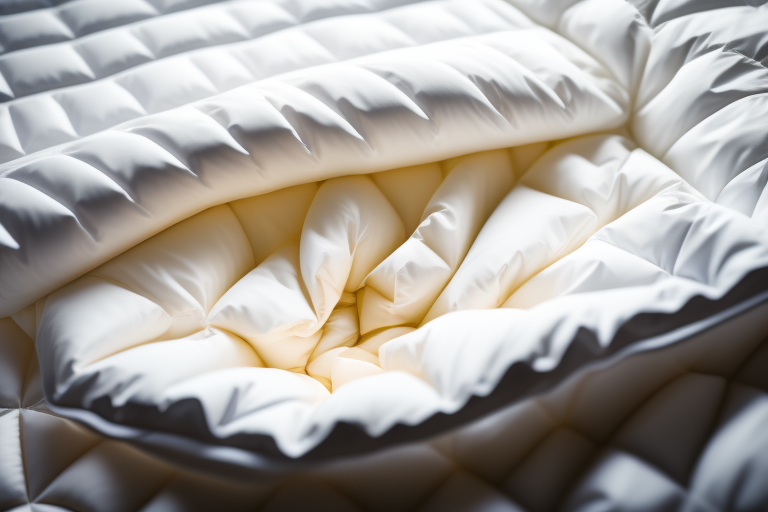Down comforters make a heavenly addition to any bed. Who doesn’t love snuggling under a lofty, fluffy cloud of down filling encased in a soft, breathable shell? As cozy and dreamy as down comforters feel, they do require proper care and maintenance to keep them clean, dry, and comfortable for years of blissful slumber.
What Is a Down Comforter?
A down comforter consists of a fabric shell or cover stuffed with down filling, the soft, fluffy cluster of filaments that lie underneath the feathers of ducks and geese. This natural down filling is incredibly warm, lightweight, and breathable – perfect for trapping body heat without causing you to overheat.
The outer shell of a down comforter is typically made from lightweight fabrics like cotton, cotton sateen, silk, or polyester microfiber. A duvet cover slips over the comforter inside a duvet to protect the shell fabric.
Why Choose a Down Comforter?
Down comforters offer exceptional warmth without weight. The fluffy down clusters trap air to provide excellent insulation and maintain body heat. Lofty down filling also allows airflow to keep you comfortable all night long.
Other benefits of down comforters:
- Lightweight and easy to move around
- Moldable and breathable – conforms to your body shape
- Hypoallergenic options available
- Durability – lasts for years with proper care
- Luxurious softness for a cozy feel
Maintaining good bedroom hygiene is essential for cleanliness and health. Washing bedding regularly eliminates allergens like dust mites, body oils, and dead skin cells that accumulate over time.
How Often Should You Wash a Down Comforter?
Experts recommend washing your down comforter 2-3 times per year at a minimum. Wash more frequently if you sweat excessively at night, have pets that sleep in bed with you, or notice visible stains on the comforter shell.
Follow these signs that indicate it’s time to wash your down comforter:
- Musty or damp odor from body oils and humidity
- Visible dirt, stains, or dust
- Clumping of down filling or bald spots
- Allergy symptoms worsen at night
Spot clean stains immediately before they set using a gentle upholstery cleaner or hydrogen peroxide. Pre-treat heavily soiled areas for best results.
Preparing Your Down Comforter for Washing
Follow these steps to get your comforter ready for a refreshing bath:
- Check the care label for any special washing instructions.
- Remove the duvet cover if using one. Wash duvet covers separately.
- Close zippers, hooks, or clasps.
- Check for holes or leaks and patch with small stitches if needed.
- Pretreat any stains or heavily soiled spots. Let them soak in according to product directions.
- Read your washing machine’s capacity – extra large comforters may need a commercial machine.
Choosing the Right Washing Machine
The size and agitation of your washing machine play key roles in properly cleaning your down comforter.
Front-loading washing machines are ideal. Top loaders with an agitator can damage the baffles that separate the down, causing clumping.
Extra-large capacity washing machines can fit king and queen-sized comforters. Measure your comforter and compare it to the machine’s listed capacity.
Run your comforter solo through the wash cycle. Overloading will prevent proper agitation.

Washing Your Down Comforter in a Machine
Follow these steps for safely washing your down comforter at home:
- Select the delicate or gentle cycle on warm or cool water. Hot water can damage down.
- Use a mild detergent without bleach or fabric softener.
- Run the rinse cycle twice to fully remove detergent residue.
- Choose low spin speed to extract water gently without damaging the comforter.
- Air dry your comforter after washing – avoid the dryer.
Water Temperature Guide
- Warm water 105°F to 115°F for lightly soiled comforters
- Cool water 80°F to 90°F for heavily soiled comforters
Suggested Detergents
- Woolite or other down-safe detergents
- Mild, clear baby detergents
- Allergen-fighting detergents like All
Avoid regular laundry detergents as they can strip the natural oils in down and cause it to dry out. Bleach and fabric softeners can also damage down clusters.
Drying Your Down Comforter
Improper drying can lead to a lumpy, misshapen comforter, so take care in the final step. Follow these air drying methods:
Outdoor drying: Lay your comforter flat on a clean, dry surface in the sun. Turn the comforter every 30-60 minutes.
Indoor drying: Use a drying rack or clean shower rods to hang up your comforter. Allow 1-2 days for full drying.
Tennis balls in the dryer: If you must use the dryer, add 2-3 tennis balls to fluff the down. Use air fluff or no heat for 15-20 minutes. Repeat cycles until fully dry.
Always make sure your down comforter is completely dry before using or storing to prevent mold and mildew growth. The filling should feel springy and lofty throughout when fully dry.
Fluffing Your Comforter
Once fully dry, fluff your comforter vigorously by hand to break up any remaining clumps and distribute the down evenly.
Gently stretch and massage the comforter to fill out corners and edges. Pay special attention to seams and baffle boxes where down can collect.
Use the tennis balls method above periodically to maintain even distribution of the filling over time.
When to Take Your Down Comforter to the Pros
Some large comforters, delicate shells, and specialty down require professional cleaning services:
- Dry cleaning: Recommended for silk, wool, or very delicate shell fabrics.
- Commercial washing machines: For washing large king and CA king size down comforters at laundromats.
- Professional fluffing service: Helps redistribute down and reverse significant clumping issues.
Look for laundromats and dry cleaners that specialize in down bedding for best results. Discuss your specific comforter’s needs.

Extend the Life of Your Down Comforter
With repeated washings and use over time, down comforters do eventually show signs of wear and will need replacing. Proper care and maintenance helps maximize your comforter’s lifespan.
Look for:
- Down poking out of small holes in the shell
- Significant thinning, flat spots, or loss of loft
- Broken baffle boxes causing shifting and bunching
To make it last:
- Use a duvet cover to protect the shell
- Wash gently and air dry completely
- Store uncompressed during warm months
- Fluff regularly to maintain even fill distribution
Expect high quality down comforters to last around 10 years with proper care. Budget options may start losing down after 5 years.
Storing Your Down Comforter
During warmer months when not in use, store your comforter properly to maintain quality:
- Wash and then fully air dry your comforter before storage.
- Place in a breathable cotton or mesh storage bag.
- Store flat in a cool, dry place like a closet shelf or under the bed.
- Avoid compression which can damage the loft.
- Refluff occasionally while stored to prevent clumping.
Proper storage will keep your comforter clean and prevent premature breakdown.
Key Takeaways on Washing Down Comforters
- Check care labels and pre-treat stains before washing
- Use a front loading machine if possible
- Wash solo on delicate cycle with mild detergent
- Rinse twice to remove all detergent residue
- Air dry completely before use or storage
- Fluff frequently to maintain even fill distribution
- Dry clean silk, wool, or delicate shells
- Replace deteriorating comforters for best sleep quality
With the proper care, your down comforter will deliver years of warm, cozy comfort. Treat it gently, keep it clean, and you’ll be catching sweet dreams beneath its softness for seasons to come.
Frequently Asked Questions
What is the best way to clean a down comforter at home?
The best way to clean a down comforter at home is to use a front-loading washing machine, wash on a gentle or delicate cycle with cool water, use a mild detergent without bleach, and rinse twice. After washing, air dry the comforter completely before using or storing.
How can I dry a large down comforter indoors?
To dry a large down comforter indoors, use a drying rack or hang it over multiple shower rods to allow air circulation. Keep interior doors open and use fans to speed up drying time. Allow 1-2 days for thorough air drying.
When should I take my down comforter for professional cleaning?
Take your down comforter to a professional cleaner if it’s extremely large and your home machine can’t accommodate it. Silk, wool, or delicate shell fabrics are also best cleaned professionally. If your comforter has significant clumping issues that don’t improve with home washing, opt for professional fluffing services.
What is the best way to store a down comforter?
The best way to store a down comforter is in a breathable cotton or mesh storage bag, flat in a cool, dry place like a closet shelf or under the bed. Avoid compression and allow air circulation. Refluff periodically while stored to maintain loft.
How do I know when it’s time to replace my down comforter?
Replace your down comforter when you notice down poking out of holes, thinning spots with loss of fluff, flat areas that won’t re-loft, or broken baffles causing bunching and shifting. A good quality down comforter typically lasts around 10 years with proper care before needing replacement.








